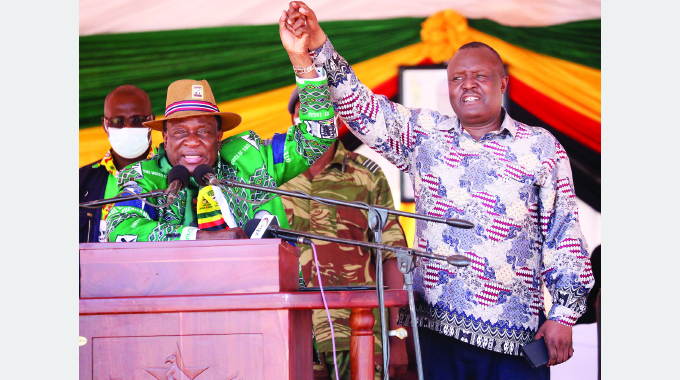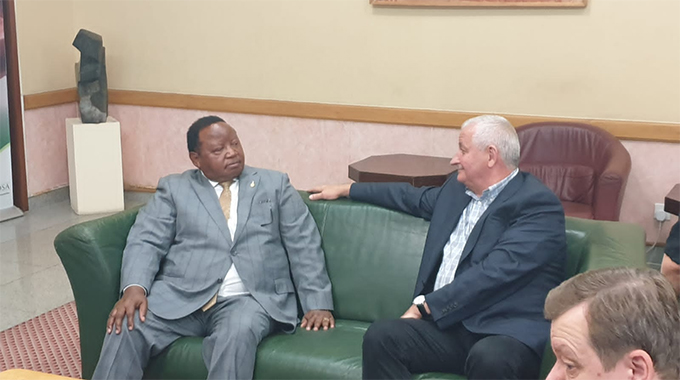2nd Republic delivering today, forever

Political Editor
SOON every household will have electricity through a US$800 million facility that will light rural households while future generations will draw from the country’s mineral vaults following the passage of a new policy on royalties.
Apart from that, rural areas like Chiredzi will also benefit from the ongoing developmental projects being implemented by President Mnangagwa as he lives up to his promise of “leaving no one and no place behind’.
In Chiredzi, home to the minority tribes of Shanganis, the President took the Second Republic tidings of community-based development that will see the drilling of boreholes in every village, schools’ construction and setting up of community radios, all programmes that respond to community needs.
In his address at a Star Rally in Chiredzi over the weekend, President Mnangagwa articulated programmes and policies his Government has implemented which are changing the face of communities around Zimbabwe.
For instance, the lowveld has been closed off from the rest of the country, getting radio signals from neighbouring countries like Mozambique and South Africa but in February this year, a new radio station, Avuxeni, went on air, the first of community radio stations that have been set up by the Second Republic across the country.
“Here in Chiredzi, the most spoken language is Shangani, we said everyone should have access to a radio that communicates directly with them and we set up a radio station here. There is no one who can say our language is not spoken on the radio, we recognise that there is no one language which is more important than the other language,” the President said.
This is actualisation of development that leaves no one and no place behind as every community is brought on board towards the country’s shared Vision 2030.
In terms of industrialisation and modernisation, which are both pillars towards the attainment of the country’s vision as expressed in the National Development Strategy 1 (NDS1), President Mnangagwa also announced that a US$800 million rural electrification programme will be launched this month to leapfrog the development of communities once considered remote but which are now being opened by the Second Republic.
This is part of the Second Republic’s rural development agenda which seeks to build smart villages that come with electricity, potable water and nutrition gardens watered by solar powered boreholes.
“We have a programme which is coming at the end of this month. President Paul Kagame of Rwanda is visiting us for this occasion,” the President said.
“This is after I spoke to him to say fellow brother, our country Zimbabwe is on sanctions but we have a programme to ensure everyone has access to electricity wherever they are.
“President Kagame then spoke to his friends and he secured US$800 million. So, that is the facility that he is coming to launch,” said President Mnangagwa.
This game-changing programme is also manifestation of the success of President Mnangagwa’s engagement and re-engagement drive that has seen the country luring investors from across the world despite the deleterious effects of illegal economic sanctions that were imposed by Western countries.
Looking beyond short-term benefits for the population, the President also announced a game changing policy in the mining sector that will benefit future generations from proceeds of minerals, like gold and diamonds which, although vast, are a finite resource even as they damage the environment.
President Mnangagwa enunciated how the policy, that came into effect on October 1, will work in his weekly instalment in yesterday’s edition of The Sunday Mail.
“We have unveiled a new policy of building and accumulating national reserves in precious and high-value minerals. I am talking about building national stocks of real precious and processed high-value strategic minerals, so we physically deposit these in our national vaults, both for us and for future generations,” the President said.
This policy will among other things end colonial profligacy, where the country’s former exploitative colonisers looted Zimbabwe’s mineral resources, stashing them in their countries.
“We have decided on this new policy which is dynamic and which for a start targets four of our key minerals. Two of them are precious; they are gold and diamonds. These must now be stockpiled both for prudence and inter-generational equity. The other two are high-value minerals, and these are lithium and platinum groups of metals, PGMs.
“As with all other non-renewables, these strategic minerals are finite. They will exhaust at some stage in the life of our nation. When that day comes, we have to have something to show and share with those who come after us. Hence, this policy we have just unveiled, which takes effect from this month of October 2022 onwards. I would have wanted this to start last month, in September; this could not happen since certain things needed finalising. Now we are ready.”
The policy entails mining companies paying their royalties partly in processed minerals and also in dollars.
Government also has a masterplan that is transforming hitherto marginalised communities into areas of growth with the capacity to economically contribute to the national gross domestic programme.
Chiredzi is one of such areas that have been marked for transformation in the shortest possible time.
Other areas that will be transformed under the master plan include Kanyemba in Mashonaland Central, Gwayi-Shangani and Binga in Matabeleland North, Beitbridge in Matabeleland South, and also Pfungwe and Kotwa in Mashonaland East among other places.
The thrust of the President is to empower communities that have for long been left behind while tapping into their time-honed skills to contribute to economic growth and mordenisation.
Chiredzi, in particular, has advanced infrastructure that also includes large water sources such as Bhangala and Tugwi-Mukosi and it is for that reason that it became the first port of call for Government to start in earnest the transformation process in line with President Mnangagwa’s Vision 2030.
Under the programme, that is already being implemented, disadvantaged communal farmers will be turned into communal/commercial farmers who will farm all year round instead of coaxing a living from seasonal cropping relying on rain-fed agriculture.
Chiredzi, which also encompasses the much talked about but misunderstood Chilonga communal areas, will see irrigation of more than 20 000 hectares of land and only 6000ha will be under Lucerne grass cultivation to support livestock production.
Historically, multilaterals have elbowed indigenous people from their fertile lands and now the Second Republic seeks to empower instead of disempowering while also modernising and mechanising.











Comments